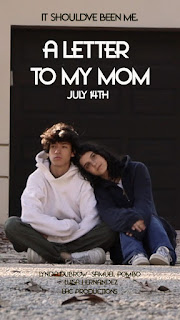My documentary
project is titled "Cracked Under Pressure” and was directed by Mariana
Sanin and I. Our topic, and main idea, was about the negative effects of the
American School system on modern day teens. We had two main subjects, Alejandra
and Peyton, and their relatives: one’s sister and one’s father. The first
subject, Alejandra, moved here from another country and had to adapt to this
new system, and Peyton has to do schoolwork on top of busy extracurricular
activities. They both struggle at balancing school with other hardships, and
they explain their experiences in the documentary.
As previously stated,
we wanted to represent the negative effects of schooling in the U.S. has on
students. Mariana and I know that this is an issue we just had to cover. These
effects, like stressing out to the point of burn-out and mental health issues,
is something that felt close to home in a school of nearly 5,000 diverse students.
We have seen people struggle and we wanted to bring awareness as well as
explain what is so negative about the way U.S. schools deal with academic
pressure. We felt that getting two perspectives on this certain situation pulls
in the representation theory as well. You have this girl who is an immigrant, who
has been exposed to schooling unlike the one most of us here are used to. She
represents Hispanic immigrants, or any immigrants for that matter, whose
parents moved here to the U.S. to give their children a better life. She
represents the children who feel at a disadvantage because of the language barrier.
Peyton, on the other hand, represents all the student athletes out there who barely
time have to do homework. They need to rely on and be good at time management,
if not they fail. Both girls are extremely different, but the pressures of
doing well in school on top of everything is a priority. As it is in American society.
It’s become a problem so big that a lot of mental health issues originate from
being in school across the nation. Yes, there are some benefits, but in this documentary,
we are displaying just the negative effects. By doing this, we as directors
also represent bias and companies controlling the media because we controlled
and made the documentary as exactly what we wanted people to know. We were not
only able to get different representation of different people, but also of a
representation of bias and social ideas on schooling.
The documentary
engages with audiences by capturing that human aspect. Our target audience
would be middle class teenagers that would have access to this documentary and
would be able to relate to things being said in it. Specifically in the 13-18
age group. Instead of using direct interviews, we used indirect ones with lengthy
answers that way you could feel the subjects are talking from the depths of their
hearts directly to you, an audience member. Projects usually do better when they feel
genuine, because who wants to watch something where they are being lied to
right? So why not do the same for our documentary when it concerns our target
audience. I also think that the b-roll we used and the use of two subjects
instead of one engaged the audience further. It made the piece less monotone
and kept people on their toes. It made sure not only one person’s opinion and
experiences were shown, but to show the validity of what they are saying. If it
applies to two completely different people without ever having met each other, it
must be true to some extent. It’s like science after all.
Of course, we couldn’t
start doing a documentary without knowing what one entails and should look
like. In class we watched different types of documentaries such as Exit
Through the Gift Shop, American Promise, and Abstract. Each one taught me
something different about the elements a documentary should have, how narrative
works, hoe bias works and how exactly to get an emotional response out of
someone. I wanted to take it a step further from just class time and research techniques
on my own. I researched what makes the documentaries so personal, apart from
what they say, and almost everything led to b-roll. Specifically hand-held
shots, so that is what we did. Almost all the b-roll I took of Alejandra doing
everyday tasks isn’t steady, it’s all handheld. It is also one among the many
common conventions we used. We also used archive footage for b-roll, because
even though we could film some on our own, the subjects also talked about
things in the past and we wanted the audience to be able to see what they are
talking about. For example, Peyton talked about her past experiences and we used
pcitires found on her Instagram to show people what she was referring to and to
not make the audience disconnect with the story so quickly. Basically, to keep
them engaged.
The genre of this
documentary, as researched, would be considered one of six. In this case it
would be an expository. This documentary was heavily researched into finding
data for the statistics in the beginning and end and finding people that would
help us represent what we wanted. It was also made to educate people that teens
are struggling in school and the extent academic pressure really goes in these
types of schools.




No comments:
Post a Comment